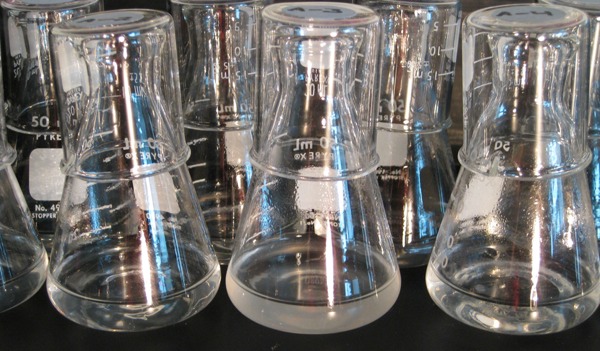Bacteria learn new trick
Scientists show evolution in action in decades-long E. coli study

E. coli bacteria live naturally in the human gut. For almost 25 years, researchers at Michigan State University in East Lansing have been growing the germs in 12 glass flasks. The microbes have been growing, and reproducing — and growing some more. Meanwhile, biologists have been watching, watching, watching.
Richard Lenski and his coworkers recently reported a new finding from the long-term project. In one flask, the bacteria the scientists were nurturing did something momentous: They gradually evolved, or changed. In this case, the tiny organisms developed the ability to eat a new food — citrate — but only when oxygen is around.
That may not seem like such a big deal, and it’s not — for humans. But for the E. coli bacteria that these biologists have been studying, learning to eat citrate as food is as momentous as growing eyes or wings would be for larger creatures with lots of cells, says Paul Rainey. Rainey, who did not participate in the new study, works at Massey University in Auckland, New Zealand, and at the Max Planck Institute for Evolutionary Biology in Plön, Germany.
The new experiment shows that evolutionary changes don’t pop up overnight — they emerge from the gradual accumulation of changes in an organism’s genes. A gene is information that’s passed from a parent to an offspring. But every generation — such as your parents’, your grandparents’, yours — tends to have some slightly different genes than the one before. Those changes add up and can lead to bigger, more obvious changes in behaviors or body functions. That’s what happened in the case of the E. coli, a type of germ that can infect the digestive tract of animals, including people.
“The ability to be able to not just talk about how genes evolve, but to see it in action is just awesome,” Emory University biologist Bruce Levin told Science News. Levin says the Michigan study clearly shows how organisms change over time. “This is really getting at the nitty-gritty of evolution.”
Ancient E. coli bacteria used to be able to eat citrate, observes biologist Zachary Blount, who works with Lenski at Michigan State. At some point about 1.3 million years ago, the microbes lost that ability, he told Science News.
Lenski’s team tracked the evolutionary change in the bacteria’s diet through about 13,000 generations. (It would take humans roughly 250,000 years to go through that many generations.)
The Michigan State biologists find that this process had three steps. In the first, at least two important genes mutated, or changed. This prepared the cell to eat citrate. During the second step, an unused gene that could move citrate within the cell became active again. In the final stage, that gene got busy, and the cell adapted other tweaks necessary to gobble up citrate.
The study doesn’t only tell scientists how the bacteria evolved; it also may help demonstrate how other, larger organisms change over time.
Power Words
E. coli A bacterium whose formal name is Escherichia coli. There are many strains — or types — of bacteria within this species, each having different traits. Many are transmitted in tainted foods and are capable of causing severe disease in people.
evolution A process by which a species changes over generations.
cell The smallest structural and functional unit of an organism, typically microscopic.
bacteria (also microbe) A single-celled organism. Bacteria lack some of the cell organization seen in other types of cells.
flask A type of container with a narrow neck. In the laboratory, sterile flasks made from glass are used for conducting chemical and biological experiments.
generation A set of members of a family regarded as a single group — your parents are one generation, your grandparents another, for example.







